CMP Releases 2019 Competition Rules
January 10, 2019
Civilian Marksmanship Program▸The First Shot▸CMP Releases 2019 Competition RulesBy Gary Anderson, DCM Emeritus
CMP Competition Rulebooks that will govern all CMP sponsored and sanctioned competitions in 2019 have now been approved by the CMP Board’s Rules Committee and posted on the CMP website. Significant changes in this year’s rulebooks include dividing the former Service Rifle and Pistol Rulebook into two separate rulebooks, the establishment of a new program to give persons with disabilities an opportunity to earn Distinguished Badges and the creation of separate unlimited classes for Modern Military Rifles and Rimfire Sporter Rifles. 2019 CMP Competition Rulebooks are effective immediately and can be downloaded from the CMP website by using the following links:
- Highpower Rifle Competition Rules, governs Service Rifle and Long Range Rifle;
- Pistol Competition Rules, governs Service Pistol and 22 Rimfire Pistol;
- CMP Games Competition Rules, governs As-Issued Military Rifle, Modern Military Rifle, Vintage Sniper Rifle Team Match, Rimfire Sporter Rifle and As-Issued Pistol;
- Smallbore Rifle Competition Rules, governs CMP traditional Smallbore Rifle Position and Prone.
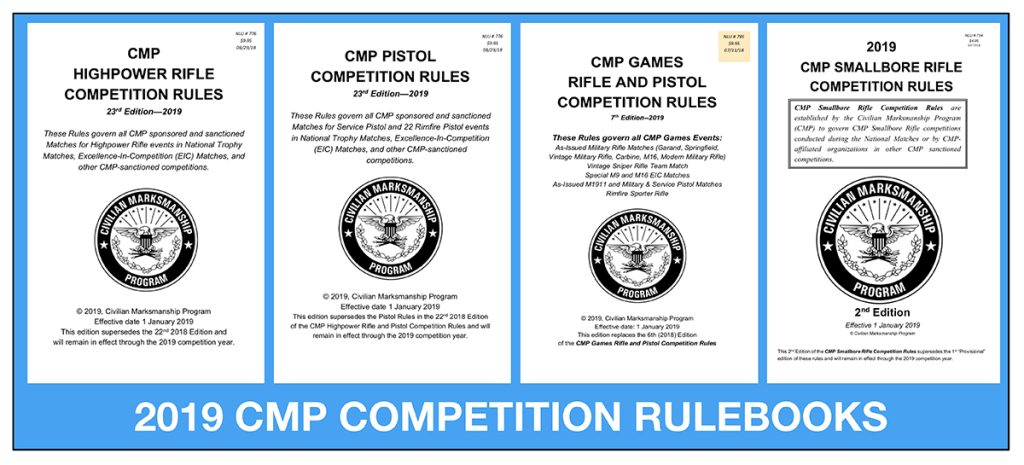
How Are CMP Rules Decisions Made?
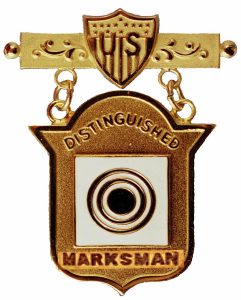
The CMP process for producing its annual competition rulebooks starts with match sponsors and competitors who submit questions and comments for rule clarifications and changes as well as recommendations for new rules. CMP staff members who conduct competitions also prepare recommendations regarding rules issues that arise during competitions. The task of evaluating these comments and recommendations is carried out by a group of Rules Advisors who also formulate new rules drafts. CMP Rules Advisors include the Chief Operating Officer, Programs Chief, Director of Civilian Marksmanship Emeritus, staff members who are directly involved in conducting competitions and experts from the competitor community. They prepare draft rulebooks for the CMP Rules Committee to review and approve. The CMP Board of Directors has final authority over CMP competition rules, but it delegates authority to approve rules to a smaller group of Board Members called the CMP Rules Committee. Each member of this body has extensive competitive shooting experience.
Competitors who want to provide input regarding CMP Rules are always encouraged to contact the CMP Competitions Department at competitions@thecmp.org or 419-635-2141, ext. 714.
Changes in All Rulebooks
Some changes in the 2019 CMP Competition Rulebooks will appear in all CMP rulebooks. They include:
-
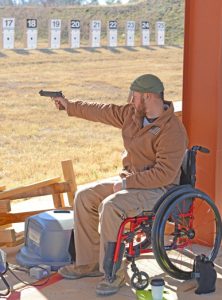
Starting in 2019, CMP Competition Rules will allow competitors who previously could not receive EIC credit points to apply for Distinguished Marksman Authorizations that will allow them to earn EIC credit points that count towards the awarding of a new Distinguished Marksman Badge. New Distinguished Marksman Program. A major new CMP program being introduced in 2019 is the Distinguished Marksman Badge Program for competitors with medical or physical limitations or disabilities. The new program will give them their first opportunity to earn a coveted Distinguished Badge. To implement this program, the CMP is establishing a new Distinguished Badge called the Distinguished Marksman Badge. The badge will be similar in appearance to current Distinguished Rifleman and Distinguished Pistol Shot Badges and it will be just as difficult to earn. Authorized participants in this program will compete in regular EIC or National Trophy rifle or pistol matches with approved adaptive positions and/or devices. If they fire a score in an EIC match that equals or exceeds the score fired by an able-bodied competitor who earned EIC points, they will receive the same number of points that count towards the 30 points required for them to earn the Distinguished Marksman Badge.Any rifle or pistol competitor with a disability or limitation that previously prevented them from fully meeting rules requirements for earning EIC credit points is invited to apply to the CMP for a “Distinguished Marksman Authorization” (contact acantu@thecmp.org or phone 419-635-2141, ext. 602). Initial authorizations will go to competitors whose proposals for adaptive positions and equipment provide for some degree of comparability. The CMP expects 2019 to be a “learning year” for this program as efforts will be made to expand it to offer Distinguished Badge opportunities to more persons with disabilities.
- Part-Year Reservist Option Ended. For at least six decades, Army Regulations and subsequent CMP Rules allowed Military Reservists who did not receive military marksmanship program support in the first part of a year to compete as civilians or civilian juniors until they started to receive marksmanship support, at which time they would revert to Reserve status. This rule always presented interpretation problems and led to occasional protests. After reevaluating this special exception, a decision was made to end it. Starting in 2019, any member of the National Guard or Reserves must compete in the Reserve Category for the entire year.
- Electronic Scoring Target Rules. New electronic target (EST) installations at the Talladega Marksmanship Park as well as temporary EST installations at CMP Travel Games necessitated the development of special rules to govern the resolution of complaints and irregular shots that occur on electronic targets. CMP EST rules were updated this year, based on EST experiences gained from these installations. CMP Rules now define EST complaint resolution processes for 1) a protested shot value; 2) a missing slow-fire shot; 3) a missing rapid-fire shot; 4) an extra slow-fire shot and 5) an extra rapid-fire shot. Range Officers who plan to work matches where EST are used need to study these new rules before their next competition.
-
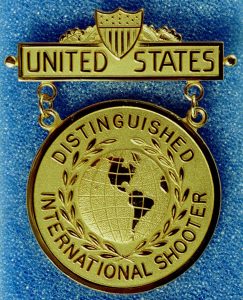
USA National Team members who win ISSF Championship medals in the new Olympic events for mixed teams (one man, one woman) now will receive credit points for earning the International Distinguished Badge. International Distinguished Badge. The International Distinguished Badge is usually considered the most difficult Distinguished Badge to earn, because competitors must first qualify for a USA National Team that competes in the Olympic Games or an ISSF World Championship, World Cup or Continental Championship. A point system also determines International Distinguished Badge winners. The one 2019 change is a recognition that the two USA team members who win medals in the new air rifle, air pistol and trap mixed team events will each receive the same EIC credit points that athletes who win individual medals receive.
Highpower Rifle Rule Changes
- Separate Highpower Rifle Rulebook. Until this year Service Rifle and Pistol events all had the same rulebook. As a result, rules frequently skipped from rifle to pistol and back and this often caused confusion. Now there are two separate rulebooks, one for Highpower Rifle and a separate rulebook for Pistol.
- Long Range Rifle Classification System. The CMP brought Long Range Rifle competitions at 800, 900 and 1000 years back to Camp Perry and the National Matches in 2018. This successful new program attracted 182 competitors who made 454 event entries. Rules for the CMP Long Range Rifle program are unchanged from the 2018 rules. This year’s change features the introduction of a Long Range Rifle classification system that will expand the CMP Highpower Rifle classification system implemented in 2018 (HP Rule 3.11.4).
- National Matches Program. The 2018 National Matches Program that introduced CMP Cup Matches, Long Range Rifle Matches and the Roosevelt Match (for U. S. Krag and M1903 rifles) will be unchanged in 2019. All of the highpower rifle events that were on the 2018 National Matches Program are already in this year’s National Matches Schedule. If you have not done so already, download the 2019 National Matches schedule at https://thecmp.org/wp-content/uploads/2019NMCalendar.pdf.
- Insufficient and Excessive Hits on Adjacent Targets.A practical change that should speed up scoring covers situations where there are 11 and nine hits respectively on adjacent targets (HP Rule 3.10.10 f). In these cases, Target Pullers should automatically score the two targets as having a crossfire on the target with 11 hits and nine hits and one miss (the crossfire) on the target next to it. In the rare case where something else may have occurred, a challenge procedure can still be used to work out what happened.
- Rifle Equipment Rules. There are no major changes in the rules governing highpower rifle equipment, but there are a few clarifications. The new rules clarify that polymer or synthetic magazines are legal for use with M16/AR-type rifles (HP Rule 4.1.1 g). A new Match Rifle rule defines the difference between fore-end attachments that are legal and palm rests that are not legal (HP Rule 4.1.5 h). Service Rifles must have slings attached in all positions (HP Rule 4.4.6). Shooting mats may be folded one time only (maximum double layer, HP Rule 4.5.4).
- Courses of Fire. There are no new courses of fire or changes from previous procedural rules. The options, first introduced in 2018, remain for highpower rifle match sponsors to use either National Match rules (no sighters, starting rapid-fire series from standing) or CMP Cup Match Rules (with sighters before each position and loading for rapid-fire in position).
Pistol Rule Changes
- Separate Pistol Rulebook. One of the biggest changes impacting the CMP pistol program is that pistol match officials and competitors now have their own separate rulebook.
- Pistol Classification System. The new rules include provisions for a pistol classification system that the CMP plans to implement in 2019 (Pistol Rule 3.11.4). Scores from Service Pistol and 22 Rimfire Pistol matches have turned out to be very similar so both events will be incorporated into one system.
- Range Safety Procedures. Previous rules required safety flags to be in pistols whenever they were carried on a range. There was some confusion, however, regarding whether this meant pistols carried in pistol boxes needed to have safety flags inserted. A new rule clarifies that when pistols are carried on ranges, safety flags must be inserted whether pistols are carried in pistol boxes, cases or uncased (Pistol Rule 3.6.1). When CMP Rules Advisors evaluated this rule, CMP Armorers who weigh triggers before matches reported encountering more than one loaded pistol that arrived at a check station. The need for being sure pistols are cleared when they come out of a vehicle at a range is obvious.
-
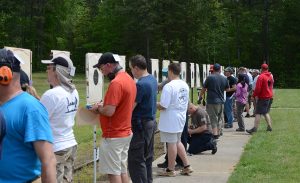
Pistol scoring rules are essentially unchanged, but they do clarify that when competitors score, they may use scoring templates to decide close shots, while only Range and Scoring Officers may insert scoring gauges. Scorers must decide scores; a Scoring Officer must decide challenges or scoring disputes. Preparation Times. Previous Pistol Range Officer scripts (scripts are found in the back of the rulebooks) provided for 3-minute preparation periods before each stage of fire including before timed and rapid-fire stages. Recommendations received from pistol competitors led to a change that eliminates preparation periods before timed and rapid-fire stages. They remain, of course, before the first slow-fire stage. When competitors return to the firing line after scoring and are called to take their positions before timed and rapid stages, commands to load for the next stage will begin after 60 seconds.
- Pistol Scoring Procedures. The new rules also seek to clarify procedures for when competitors score each other’s targets. When competitors score, they must make all initial scoring decisions. If there is a dispute between a scorer and a competitor, a Scoring Officer makes the final decision. Competitors are authorized to use scoring templates. Plug gauges can only be inserted by a Range or Scoring Officer (Pistol Rule 3.10.1).
Smallbore Rifle Rulebook
Provision Rulebook Becomes Official. The CMP also returned traditional Smallbore Rifle Position and Prone Matches to Camp Perry and the National Matches in 2018. Part of the process of bringing smallbore rifle back to Camp Perry involved the creation of “provisional” Smallbore Rifle rulebook. This rulebook was tested in 2018 and now, with CMP Rules Committee approval, has become an official CMP rulebook. The 2019 CMP Smallbore Rifle Competition Rules are essentially unchanged from the rules that governed the 2018 Smallbore Rifle Championship.
CMP Games Rule Changes
The CMP Games Rulebook that governs As-Issued Military Rifle and Pistol events as well as Rimfire Sporter Matches has some of the most significant 2019 rule changes. These include the establishment of an Unlimited Modern Military Rifle Class and the expansion of the Rimfire Sporter Tactical Class to become a combined Tactical and Unlimited Class (TU-Class). Changes in this rulebook are.
-

The presentation of gold, silver and bronze Achievement Medals and Pins is a popular conclusion to many CMP sponsored and sanctioned competitions. As-Issued Military Rifle Events. The core of the CMP As-Issued Military Rifle program is the ever-popular Garand-Springfield-Vintage Military Rifle triad. Those events and the Carbine Match, which accompanies them on many match programs, remain unchanged.
- Achievement Award Scores. The chart of CMP Achievement Award Scores that determines the winners of gold, silver and bronze Achievement Medals and Pins is updated annually based on scores fired in previous year’s matches. All changes this year were minor, but cut scores in several events actually went down slightly. The newest Achievement Award Scores are found in Annex G at the end of the CMP Games Rulebook.
-
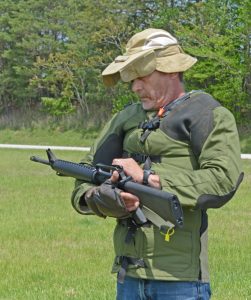
In 2019, the “Standard Modern Military Rifle” will return to its original rules for AR-type rifles that featured a 7.5 lbs. maximum weight and metallic sights only. In 2019, AR-type rifles that weigh more than 7.5 lbs. or that have optical sights will compete in a separate Unlimited Class. Modern Military Rifle. CMP began promoting Modern Military Rifle events in 2013 when it added Modern Military Rifle 30 and 50-shot events to the rules. The objective of this match was to encourage gun owners with popular AR-platform rifles to use them in target rifle shooting. The original Modern Military Rifle rules featured a 7.5 lbs. weight limit, restricted rifles to metallic sights and prohibited accurizing modifications that were common on M16-type match rifles. The new events proved to be popular, but every year there were more competitors who wanted to use rifles that were heavier or had accurizing features like float tubes. This was not helped by a 2016 rule change that allowed optical sights and raised the AR weight limit to 8.5 lbs. To find a way to cope with this situation, the CMP began experimenting with a separate Unlimited Modern Military Rifle Class in 2018.
For 2019, after much debate and inputs from many, the CMP decided to return the first Modern Military Rifle Class to its original rules as a Standard Modern Military Rifle and to establish a separate Unlimited Modern Military Rifle Class. The Standard Modern Military Rifle will go back to its original 7.5 lbs. weight limit for AR-type rifles and 9.0 lbs. for M1As. Standard Modern Military Rifles will be restricted to metallic sights only. Rifles that weigh more than 7.5 lbs. or 9.0 lbs. or that have optical sights will now be in the Unlimited Modern Military Rifle Class. Restrictions against float tubes or metallic sights with finer adjustments were removed for both classes.
-
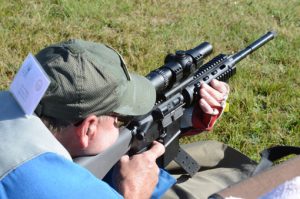
Modern Military Rifles with optical sights will now all be in the Unlimited Modern Military Rifle Class. Free-floating handguards will be allowed in both the Unlimited and Standard Modern Military Rifle Classes. Vintage Sniper Rifle Team Match. The challenge CMP rule makers faced with the Vintage Sniper Rifle Team Match was how to coordinate rules for shooting on either pit-operated targets or electronic scoring targets so that the commands, procedures and marksmanship skills tested would be comparable. The basic match remains unchanged, but the LOAD AND STANDBYcommand now means the same thing regardless of the type of targets. The uniform 2019 version of this command authorizes firers to load, close rifle actions and shoulder their rifles. Target exposures on pit operated targets remain at 20 sec., but firing times on electronic targets are shortened to 15 sec. This shorter firing time compensates for the fact that teams firing on electronic targets know their shot locations instantly and can make wind calls and aiming decisions during scoring times while teams firing on pit-operated targets don’t know shot locations and cannot make aiming adjustments until after targets come back up for firing.
- Rimfire Sporter Rifle TU-Class. The main Rimfire Sporter rule change is an expansion of the Tactical Class into a Tactical and Unlimited Class (TU-Class). The problem that arose in Rimfire Sporter competitions was increasing interest in using non-conventional rifle configurations with features like thumb-hole stocks, adjustable stock features, different pistol grips and innovative barrel configurations. Fundamentally, Rimfire Sporter Rifle shooting is supposed to be done with “standard sporter-type rifles of standard appearance.” CMP rule makers had to decide what to do with customized and non-conventional rifles while still trying to keep T-Class and O-Class rifles as close as possible to standard production rifles.
To do this, the Tactical-Class, which was originally created for a wide variety of AR-clones, was expanded into a Tactical and Unlimited Class (TU-Class). Rules for T-Class and O-Class rifles were strengthened by requiring them to have “conventional” sporter type stocks and straight or standard barrel contours. Rifles that do not readily fit into the T-Class or O-Class will now be placed in a new TU-Class. All rifles in the TU-Class still need to comply with the 7.5 lbs. weight limit and have 3 lb. triggers.
The CMP was reluctant to create a separate fourth class for non-standard or customized rimfire rifles because additional classes or categories complicate match administration and tend to water down existing classes. Instead, it opted to try the combined TU-Class. The CMP recognizes that interpretation of the new rules will present challenges, but CMP Competitions Department staff will be available to answer questions regarding how to classify rifles.
CMP Competitions Support
Anyone with questions regarding the 2019 CMP Competition Rules or who needs assistance in interpreting rules is invited and encouraged to contact the CMP Competitions Department at competitions@thecmp.org or 419-635-2141, ext. 714.